An Uncertainty Assessment of Human Health Risk for Toxic Trace Elements Using a Sequential Indicator Simulation in Farmland Soils
Abstract
1. Introduction
2. Materials and Methods
2.1. Study Area
2.2. Soil Sampling and Laboratory Analysis
2.3. Uncertainty Assessment of Human Health Risks
2.3.1. Sequential Indicator Simulation of Soil Data
2.3.2. Human Health Risk Assessment
2.3.3. Uncertainty Model Accuracy Evaluation
3. Results and Discussion
3.1. Preliminary Data Description
3.2. Uncertainty Assessment of Human Health Risk Based on SIS
3.2.1. Human health Risk Threshold of Each Trace Element
3.2.2. Human Health Risk Assessment Based on SIS
3.2.3. Uncertainty Assessment
3.3. Accuracy Evaluation of the Uncertainty Model
3.4. Discussion
3.4.1. Comparison of Human Health Risk Results
3.4.2. Selection of Risk Mapping Based on the SIS Method
4. Conclusions
Author Contributions
Funding
Acknowledgments
Conflicts of Interest
Appendix A
| Parameter | Type | Equation |
|---|---|---|
| Carcinogenic exposure value | Oral | |
| Dermal | ||
| Inhalational | ||
| Non-carcinogenic exposure value | Oral intake | |
| Dermal | ||
| Inhalational |
| Parameter | Symbol | Units | Value | Reference |
|---|---|---|---|---|
| Exposure duration of children | EDc | a | 6 | (MEPPRC, 2014)a |
| Exposure duration of adults | EDa | a | 24 | (MEPPRC, 2014)a |
| Exposure frequency of children | Efc | d·a−1 | 350 | (MEPPRC, 2014)a |
| Exposure frequency of adults | Efa | d·a−1 | 350 | (MEPPRC, 2014)a |
| Average body weight of children | BWc | kg | 56.8 | (MEPPRC, 2014)a |
| Average body weight of adults | Bwa | kg | 15.9 | (MEPPRC, 2014)a |
| Absorption factor of oral ingestion | ABSo | unitless | 1 | (MEPPRC, 2014)a |
| Average time for carcinogenic effect | ATca | d | 26,280 | (MEPPRC, 2014)a |
| Average time for non-carcinogenic effect | Atnc | d | 2190 | (MEPPRC, 2014)a |
| Exposed skin surface area of adults | SAEa | cm2 | 5074.89 | (MEPPRC, 2014)a |
| Exposed skin surface area of children | SAEc | cm2 | 2447.56 | (MEPPRC, 2014)a |
| Adherence rate of soil on skin for adults | SSARa | mg·cm−2 | 0.07 | (MEPPRC, 2014)a |
| Adherence rate of soil on skin for children | SSARc | mg·cm−2 | 0.2 | (MEPPRC, 2014)a |
| Daily exposure frequency of dermal contact event | Ev | times/d | 1 | (MEPPRC, 2014)a |
| Content of inhalable particulates in ambient air | PM10 | mg·m−3 | 0.15 | (MEPPRC, 2014)a |
| Daily air inhalation rate of adults | DAIRa | m3·d−1 | 14.5 | (MEPPRC, 2014)a |
| Daily air inhalation rate of children | DAIRc | m3·d−1 | 7.5 | (MEPPRC, 2014)a |
| Retention fraction of inhaled particulates in body | PIAF | unitless | 0.75 | (MEPPRC, 2014)a |
| Fraction of soil-borne particulates in indoor air | fspi | unitless | 0.8 | (MEPPRC, 2014)a |
| Fraction of soil-borne particulates in outdoor air | fspo | unitless | 0.5 | (MEPPRC, 2014)a |
| Indoor exposure frequency of adults | EFIa | d·a−1 | 262.5 | (MEPPRC, 2014)a |
| Indoor exposure frequency of children | EFIc | d·a−1 | 262.5 | (MEPPRC, 2014)a |
| Outdoor exposure frequency of adults | EFOa | d·a−1 | 87.5 | (MEPPRC, 2014)a |
| Outdoor exposure frequency of children | EFOc | d·a−1 | 87.5 | (MEPPRC, 2014)a |
| Soil allocation factor | SAF | unitless | 0.2 | (MEPPRC, 2014)a |
| Dermal absorption factor of Cd | ABSDCd | unitless | 0.001 | (USEPA, 2013)b |
| Dermal absorption factor of CR | ABSDCr | unitless | 0.001 | (USEPA, 2013)b |
| Dermal absorption factor of As | ABSDAs | unitless | 0.03 | (USEPA, 2013)b |
| Dermal absorption factor of Hg | ABSDHg | unitless | 0.05 | (HC, 2004)c |
| Dermal absorption factor of Pb | ABSDPb | unitless | 0.006 | (HC, 2004)c |
| Parameter | SFo (mg/kg-day) | SFd (mg/kg-day) | SFi (mg/kg-day) | RfDo (mg/kg-day) | RfDd (mg/kg-day) | RfDi (mg/kg-day) | |
|---|---|---|---|---|---|---|---|
| Carcinogenic Elements | As | 1.50 | 1.50 | 16.84 | - | - | - |
| Cd | 3.80 × 10−1 | 2.00 | 329.05 | - | - | - | |
| Non-carcinogenic elements | Hg | - | - | - | 3.00 × 10−4 | 2.10 × 10−5 | 7.66 × 10−5 |
| Pb | - | - | - | 3.50 × 10−4 | 5.25 × 10−4 | 3.52 × 10−2 | |
| Cr | - | - | - | 1.50 | 1.95 × 10−2 | 2.55 × 10−5 | |
| Element | Quantile | Threshold (mg/kg) | C0 | C0 + C1 | Fitted Model | Range(m) | R2 |
|---|---|---|---|---|---|---|---|
| Cd | 0.25 | 0.1440 | 0.1182 | 0.2704 | Exponential | 24,380 | 0.80 |
| 0.5 | 0.1751 | 0.0710 | 0.2560 | Gaussian | 2760 | 0.90 | |
| 0.75 | 0.2208 | 0.0560 | 0.171 | Gaussian | 2060 | 0.91 | |
| Hg | 0.25 | 0.0776 | 0.0001 | 0.1982 | Exponential | 1530 | 0.70 |
| 0.5 | 0.1057 | 0.0082 | 0.2484 | Exponential | 1270 | 0.83 | |
| 0.75 | 0.1520 | 0.0569 | 0.1938 | Spherical | 21,920 | 0.96 | |
| AS | 0.25 | 4.4085 | 0.0187 | 0.2014 | Spherical | 3210 | 0.65 |
| 0.5 | 8.1937 | 0.1001 | 0.2962 | Exponential | 7460 | 0.95 | |
| 0.75 | 12.6000 | 0.0419 | 0.1948 | Spherical | 17,490 | 0.98 | |
| Pb | 0.25 | 41.7199 | 0.1280 | 0.4010 | Exponential | 71,100 | 0.83 |
| 0.5 | 48.9496 | 0.1194 | 0.2548 | Exponential | 2850 | 0.88 | |
| 0.75 | 57.9000 | 0.0607 | 0.1834 | Exponential | 1350 | 0.73 | |
| Cr | 0.25 | 53.1686 | 0.1218 | 0.4286 | Exponential | 71,100 | 0.83 |
| 0.5 | 69.3163 | 0.0863 | 0.2506 | Exponential | 1830 | 0.94 | |
| 0.75 | 87.6570 | 0.0264 | 0.1938 | Exponential | 510 | 0.60 |
References
- Foley, J.A.; DeFries, R.; Asner, G.P.; Barford, C.; Bonan, G.; Carpenter, S.R.; Chapin, F.S.; Coe, M.T.; Daily, G.C.; Gibbs, H.K.; et al. Global consequences of land use. Science 2005, 309, 570–574. [Google Scholar] [CrossRef]
- Zhao, F.J.; Ma, Y.; Zhu, Y.G.; Tang, Z.; McGrath, S.P. Soil contamination in China: Current status and mitigation strategies. Environ. Sci. Technol. 2015, 49, 750–759. [Google Scholar] [CrossRef]
- Zhao, H.; Xia, B.; Fan, C.; Zhao, P.; Shen, S. Human health risk from soil heavy metal contamination under different land uses near Dabaoshan Mine, Southern China. Sci. Total Environ. 2012, 417–418, 45–54. [Google Scholar] [CrossRef]
- Järup, L. Hazards of heavy metal contamination. Br. Med. Bull. 2003, 68, 167–182. [Google Scholar] [CrossRef] [PubMed]
- Lee, C.S.L.; Li, X.; Shi, W.; Cheung, S.C.N.; Thornton, I. Metal contamination in urban, suburban, and country park soils of Hong Kong: A study based on GIS and multivariate statistics. Sci. Total Environ. 2006, 356, 45–61. [Google Scholar] [CrossRef] [PubMed]
- Cicchella, D.; DeVivo, B.; Lima, A.; Albanese, S.; McGill, R.A.R.; Parrish, R.R. Heavy metal pollution and Pb isotopes in urban soils of Napoli, Italy. Geochem. Explor. Environ. Anal. 2008, 8, 103–112. [Google Scholar] [CrossRef]
- Sawut, R.; Kasim, N.; Maihemuti, B.; Hu, L.; Abliz, A.; Abdujappar, A.; Kurban, M. Pollution characteristics and health risk assessment of heavy metals in the vegetable bases of northwest China. Sci. Total Environ. 2018, 642, 864–878. [Google Scholar] [CrossRef] [PubMed]
- Ho, Y.B.; Abdullah, N.H.; Hamsan, H.; Tan, E.S.S. Mercury contamination in facial skin lightening creams and its health risks to user. Regul. Toxicol. Pharmacol. 2017, 88, 72–76. [Google Scholar] [CrossRef]
- Zukowska, J.; Biziuk, M. Methodological evaluation of method for dietary heavy metal intake. J. Food Sci. 2008, 73, R21–R29. [Google Scholar] [CrossRef]
- Khan, A.G.; Kuek, C.; Chaudhry, T.M.; Khoo, C.S.; Hayes, W.J.; Wong, M.H. Role of plants, mycorrhizae and phytochelators in heavy metal contaminated land remediation. Chemosphere 2000, 41, 197–207. [Google Scholar] [CrossRef]
- Yi, Y.; Yang, Z.; Zhang, S. Ecological risk assessment of heavy metals in sediment and human health risk assessment of heavy metals in fishes in the middle and lower reaches of the Yangtze River basin. Environ. Pollut. 2011, 159, 2575–2585. [Google Scholar] [CrossRef] [PubMed]
- Gay, J.R.; Korre, A. A spatially-evaluated methodology for assessing risk to a population from contaminated land. Environ. Pollut. 2006, 142, 227–234. [Google Scholar] [CrossRef] [PubMed]
- Khan, S.; Cao, Q.; Zheng, Y.M.; Huang, Y.Z.; Zhu, Y.G. Health risks of heavy metals in contaminated soils and food crops irrigated with wastewater in Beijing, China. Environ. Pollut. 2008, 152, 686–692. [Google Scholar] [CrossRef] [PubMed]
- Zhao, Y.; Xu, X.; Sun, W.; Huang, B.; Darilek, J.L.; Shi, X. Uncertainty assessment of mapping mercury contaminated soils of a rapidly industrializing city in the Yangtze River Delta of China using sequential indicator co-simulation. Environ. Monit. Assess. 2008, 138, 343–355. [Google Scholar] [CrossRef] [PubMed]
- Zhuang, P.; McBride, M.B.; Xia, H.; Li, N.; Li, Z. Health risk from heavy metals via consumption of food crops in the vicinity of Dabaoshan mine, South China. Sci. Total Environ. 2009, 407, 1551–1561. [Google Scholar] [CrossRef] [PubMed]
- Man, Y.B.; Sun, X.L.; Zhao, Y.G.; Lopez, B.N.; Shanshan, C.; Wu, S.C.; Kwaichung, C.; Wong, M.H. Health risk assessment of abandoned agricultural soils based on heavy metal contents in Hong Kong, the world’s most populated city. Environ. Int. 2010, 36, 570–576. [Google Scholar] [CrossRef]
- Li, P.; Lin, C.; Cheng, H.; Duan, X.; Lei, K. Contamination and health risks of soil heavy metals around a lead/zinc smelter in southwestern China. Ecotoxicol. Environ. Saf. 2015, 113, 391–399. [Google Scholar] [CrossRef]
- Gu, Y.G.; Gao, Y.P.; Lin, Q. Contamination, bioaccessibility and human health risk of heavy metals in exposed-lawn soils from 28 urban parks in southern China’s largest city, Guangzhou. Appl. Geochem. 2016, 67, 52–58. [Google Scholar] [CrossRef]
- MEPPRC. Technical Guidelines for Risk Assessment of Contaminated Sites (HJ25.3-2014, Published in Chinese); China Environmental Science Press: Beijing, China, 2014. [Google Scholar]
- Chen, H.; Teng, Y.; Lu, S.; Wang, Y.; Wu, J.; Wang, J. Source apportionment and health risk assessment of trace metals in surface soils of Beijing metropolitan, China. Chemosphere 2015, 144, 1002. [Google Scholar] [CrossRef]
- Schuhmacher, M.; Meneses, M.; Xifró, A.; Domingo, J.L. The use of Monte-Carlo simulation techniques for risk assessment: study of a municipal waste incinerator. Chemosphere 2001, 43, 787. [Google Scholar] [CrossRef]
- Sonnemann, G.W.; Pla, Y.; Schuhmacher, M.; Castells, F. Framework for the uncertainty assessment in the Impact Pathway Analysis with an application on a local scale in Spain. Environ. Int. 2002, 28, 9–18. [Google Scholar] [CrossRef]
- Pyrcz, M.J.; Deutsch, C. V Geostatistical Reservoir Modeling; Oxford University Press: New York, NY, USA, 2014; ISBN 0199731446. [Google Scholar]
- Albuquerque, M.T.D.; Gerassisc, S.; Sierrad, C.; Taboadac, J.; Martínc, J.E.; Antuneseb, I.M.H.R. Developing a new Bayesian Risk Index for risk evaluation of soil contamination. Sci. Total Environ. 2017, 603–604, 167–177. [Google Scholar] [CrossRef] [PubMed]
- Goovaerts, P. Geostatistics for Natural Resources Evaluation; Oxford University Press: New York, NY, USA, 1997. [Google Scholar]
- Duzgorenaydin, N.S.; Wong, C.S.; Aydin, A.; Song, Z.; You, M.; Li, X.D. Heavy metal contamination and distribution in the urban environment of Guangzhou, SE China. Environ. Geochem. Health 2006, 28, 375–391. [Google Scholar] [CrossRef] [PubMed]
- Li, J.H.; Ying, L.; Wei, Y.; Gan, H.H.; Chao, Z.; Deng, X.L.; Jin, L. Distribution of heavy metals in agricultural soils near a petrochemical complex in Guangzhou, China. Environ. Monit. Assess. 2009, 153, 365–375. [Google Scholar] [CrossRef] [PubMed]
- Cai, Q.Y.; Mo, C.H.; Li, H.Q.; Lü, H.; Zeng, Q.Y.; Li, Y.W.; Wu, X.L. Heavy metal contamination of urban soils and dusts in Guangzhou, South China. Environ. Monit. Assess. 2013, 185, 1095–1106. [Google Scholar] [CrossRef]
- Goovaerts, P. Geostatistical modelling of uncertainty in soil science. Geoderma 2001, 103, 3–26. [Google Scholar] [CrossRef]
- Juang, K.W.; Chen, Y.S.; Lee, D.Y. Using sequential indicator simulation to assess the uncertainty of delineating heavy-metal contaminated soils. Environ. Pollut. 2004, 127, 229–238. [Google Scholar] [CrossRef]
- Huang, J.; Liu, W.; Zeng, G.; Li, F.; Huang, X.; Gu, Y.; Shi, L.; Shi, Y.; Wan, J. An exploration of spatial human health risk assessment of soil toxic metals under different land uses using sequential indicator simulation. Ecotoxicol. Environ. Saf. 2016, 129, 199–209. [Google Scholar] [CrossRef]
- Deutsch, C.V.; Journel, A.G. GSLIB: Geostatistical Software Library and User’s Guide, 2nd ed.; Oxford University Press: New York, NY, USA, 1998. [Google Scholar]
- Cattle, J.A.; McBratney, A.; Minasny, B. Kriging method evaluation for assessing the spatial distribution of urban soil lead contamination. J. Environ. Qual. 2002, 31, 1576–1588. [Google Scholar] [CrossRef]
- Chen, H.; Teng, Y.; Lu, S.; Wang, Y.; Wang, J. Contamination features and health risk of soil heavy metals in China. Sci. Total Environ. 2015, 512, 143–153. [Google Scholar] [CrossRef]
- US EPA. Proposed Guidelines for Carcinogen Risk Assessment. Fed. Regist. 1996, 61, 17960–18011. [Google Scholar]
- Pawełczyk, A.; Božek, F.; Grabas, K. Impact of military metallurgical plant wastes on the population’s health risk. Chemosphere 2016, 152, 513–519. [Google Scholar] [CrossRef] [PubMed]
- Katz, S.A.; Salem, H. The Biological and Environmental Chemistry of Chromium; Wiley Sons: Hoboken, NJ, USA, 1994. [Google Scholar]
- US EPA Regional Screening Levels (RSLs). Available online: https://www.epa.gov/risk/regional-screening-levels-rsls (accessed on 1 December 2018).
- Yang, Y.; Christakos, G. Uncertainty assessment of heavy metal soil contamination mapping using spatiotemporal sequential indicator simulation with multi-temporal sampling points. Environ. Monit. Assess. 2015, 187, 571. [Google Scholar] [CrossRef] [PubMed]
- AQTSGP. Risk Screening Values for Soil Heavy Metal The Pearl River Delta Area (DB 44/ T1415--2014, Published in Chinese); Guangdong Quality and Technical Supervision Bureau: Guangzhou, China, 2014. [Google Scholar]
- Li, F.; Huang, J.; Zeng, G.; Liu, W.; Huang, X.; Huang, B.; Gu, Y.; Shi, L.; He, X.; He, Y. Toxic metals in topsoil under different land uses from Xiandao District, middle China: distribution, relationship with soil characteristics, and health risk assessment. Environ. Sci. Pollut. Res. Int. 2015, 22, 12261–12275. [Google Scholar] [CrossRef]
- Yao, R.; Yang, J.; Han, J. Stochastic simulation and uncertainty assessment of spatial variation in soil salinity in coastal reclamation regions. Zhongguo Shengtai Nongye Xuebao/Chinese J. Eco-Agriculture 2011, 19, 485–490. [Google Scholar] [CrossRef]
- Wang, S.; Cao, X.; Lin, C.; Chen, X. Arsenic content and fractionation in the surface sediments of the Guangzhou section of the Pearl River in Southern China. J. Hazard. Mater. 2010, 183, 264–270. [Google Scholar] [CrossRef]
- Han, L.; Gao, B.; Hao, H.; Lu, J.; Xu, D. Arsenic pollution of sediments in China: An assessment by geochemical baseline. Sci. Total Environ. 2019, 651, 1983–1991. [Google Scholar] [CrossRef]
- Huang, M.; Wang, W.; Chan, C.Y.; Cheung, K.C.; Man, Y.B.; Wang, X.; Wong, M.H. Contamination and risk assessment (based on bioaccessibility via ingestion and inhalation) of metal (loid) s in outdoor and indoor particles from urban centers of Guangzhou, China. Sci. Total Environ. 2014, 479, 117–124. [Google Scholar] [CrossRef]
- Gu, Y.G.; Gao, Y.P. Bioaccessibilities and health implications of heavy metals in exposed-lawn soils from 28 urban parks in the megacity Guangzhou inferred from an in vitro physiologically-based extraction test. Ecotoxicol. Environ. Saf. 2018, 148, 747–753. [Google Scholar] [CrossRef]
- Duzgoren-Aydin, N.S. Sources and characteristics of lead pollution in the urban environment of Guangzhou. Sci. Total Environ. 2007, 385, 182–195. [Google Scholar] [CrossRef]
- Pariente, S.; Helena, Z.; Eyal, S.; Anatoly, F.G.; Michal, Z. Road side effect on lead content in sandy soil. Catena 2019, 174, 301–307. [Google Scholar] [CrossRef]
- Lu, J.; Ma, L.; Cheng, C.; Pei, C.; Chan, C.K.; Bi, X.; Qin, Y.; Tan, H.; Zhou, J.; Chen, M. Real time analysis of lead-containing atmospheric particles in Guangzhou during wintertime using single particle aerosol mass spectrometry. Ecotoxicol. Environ. Saf. 2019, 168, 53–63. [Google Scholar] [CrossRef] [PubMed]
- Bi, C.; Zhou, Y.; Chen, Z.; Jia, J.; Bao, X. Heavy metals and lead isotopes in soils, road dust and leafy vegetables and health risks via vegetable consumption in the industrial areas of Shanghai, China. Sci. Total Environ. 2018, 619, 1349–1357. [Google Scholar] [CrossRef] [PubMed]
- Li, C.; Sun, G.; Wu, Z.; Zhong, H.; Wang, R.; Liu, X.; Guo, Z.; Cheng, J. Soil physiochemical properties and landscape patterns control trace metal contamination at the urban-rural interface in southern China. Environ. Pollut. 2019, 250, 537–545. [Google Scholar] [CrossRef] [PubMed]
- Huang, M.; Chen, X.; Shao, D.; Zhao, Y.; Wang, W.; Wong, M.H. Risk assessment of arsenic and other metals via atmospheric particles, and effects of atmospheric exposure and other demographic factors on their accumulations in human scalp hair in urban area of Guangzhou, China. Ecotoxicol. Environ. Saf. 2014, 102, 84–92. [Google Scholar] [CrossRef] [PubMed]
- Huang, M.; Wang, W.; Leung, H.; Chan, C.Y.; Liu, W.K.; Wong, M.H.; Cheung, K.C. Mercury levels in road dust and household TSP/PM2. 5 related to concentrations in hair in Guangzhou, China. Ecotoxicol. Environ. Saf. 2012, 81, 27–35. [Google Scholar] [CrossRef]
- Xiao, S.; Zhao, Y.; Wang, B. Problem analysis of geological properties evaluation using indicator Kriging. Petrochem. Ind. Appl. 2013. [Google Scholar]
- Antunes, I.M.H.R.; Albuquerque, M.T.D. Using indicator kriging for the evaluation of arsenic potential contamination in an abandoned mining area (Portugal). Sci. Total Environ. 2013, 442, 545–552. [Google Scholar] [CrossRef]
- Journel, A.G. Nonparametric estimation of spatial distributions. J. Int. Assoc. Math. Geol. 1983, 15, 445–468. [Google Scholar] [CrossRef]
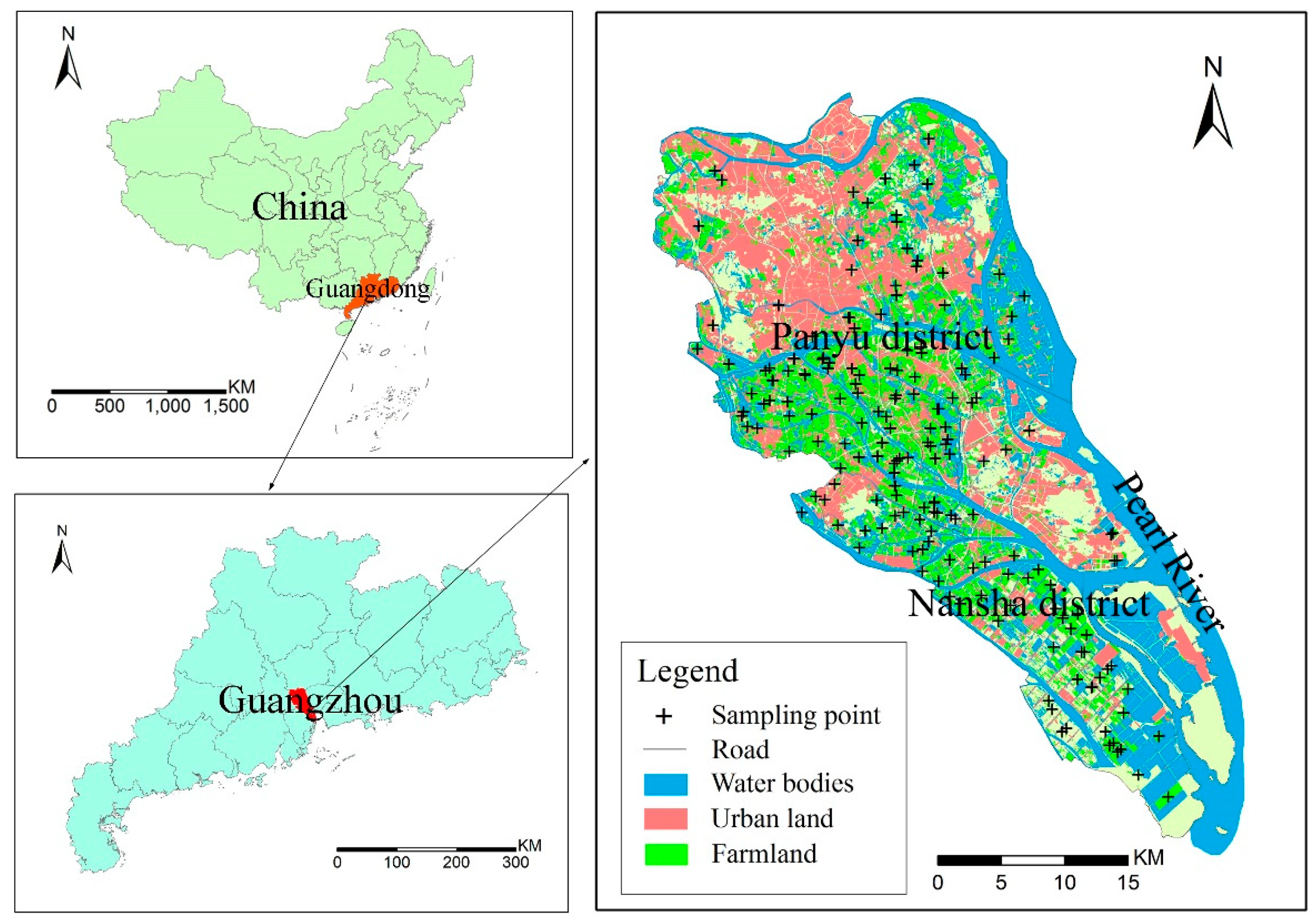
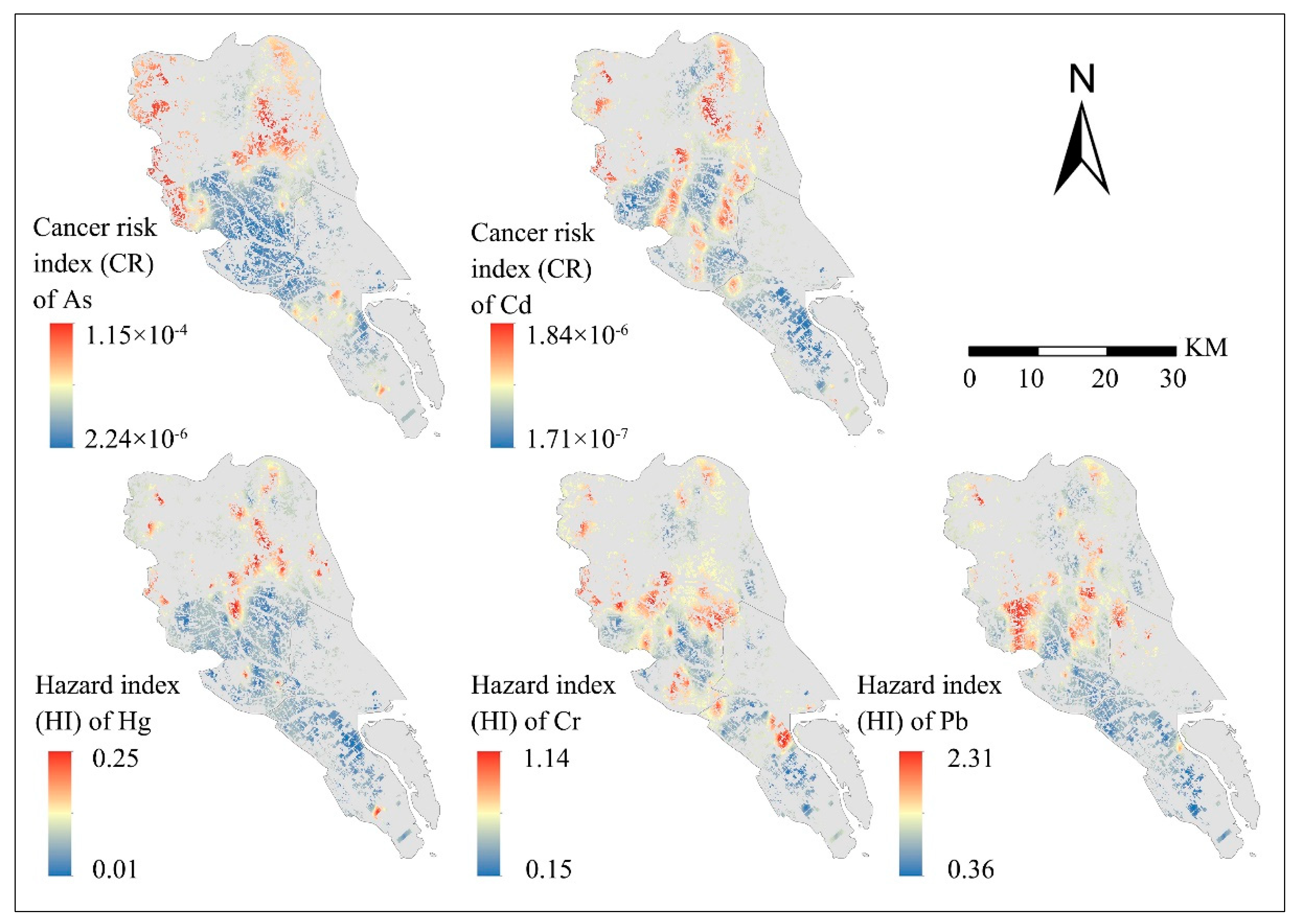
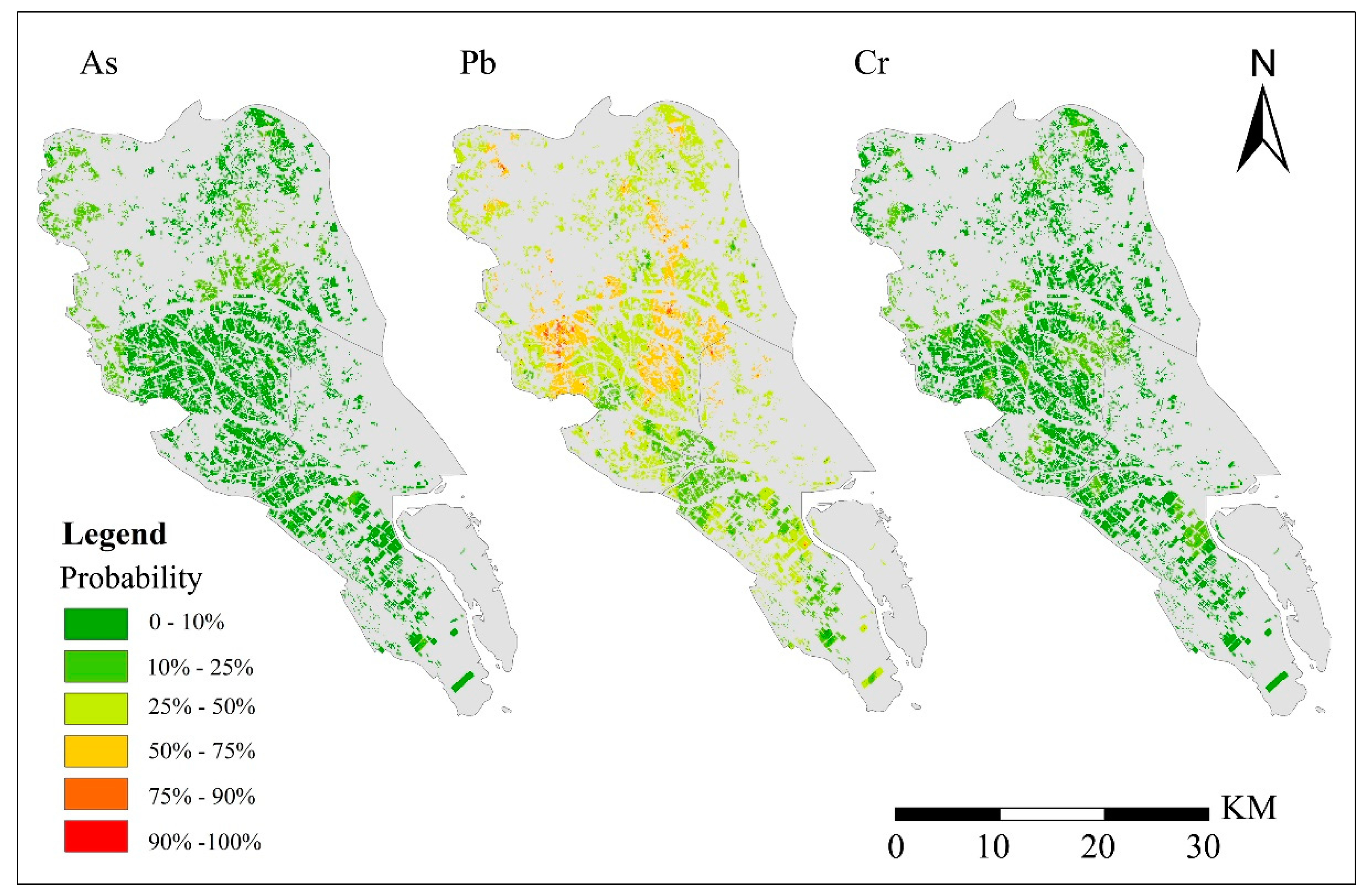
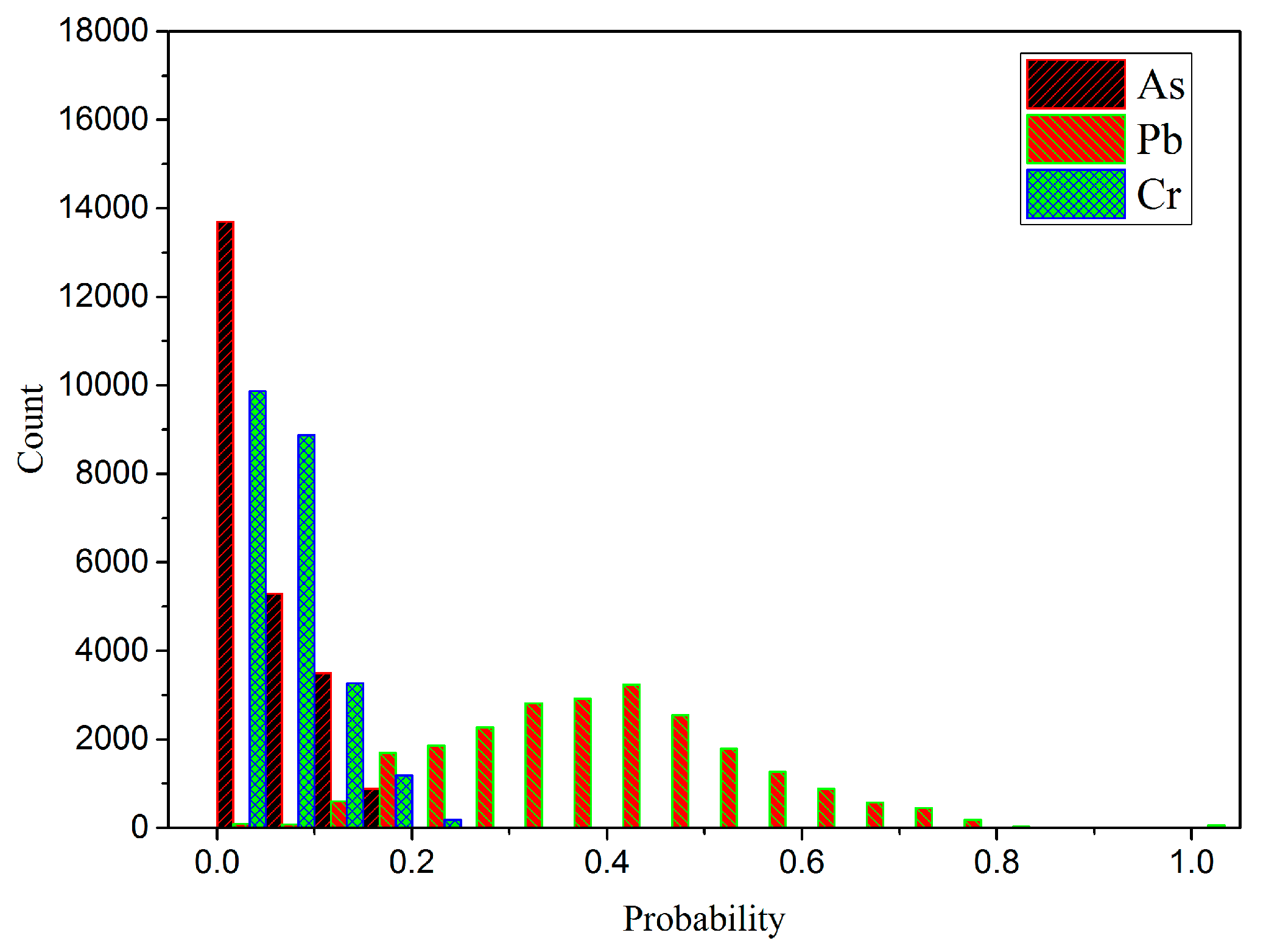
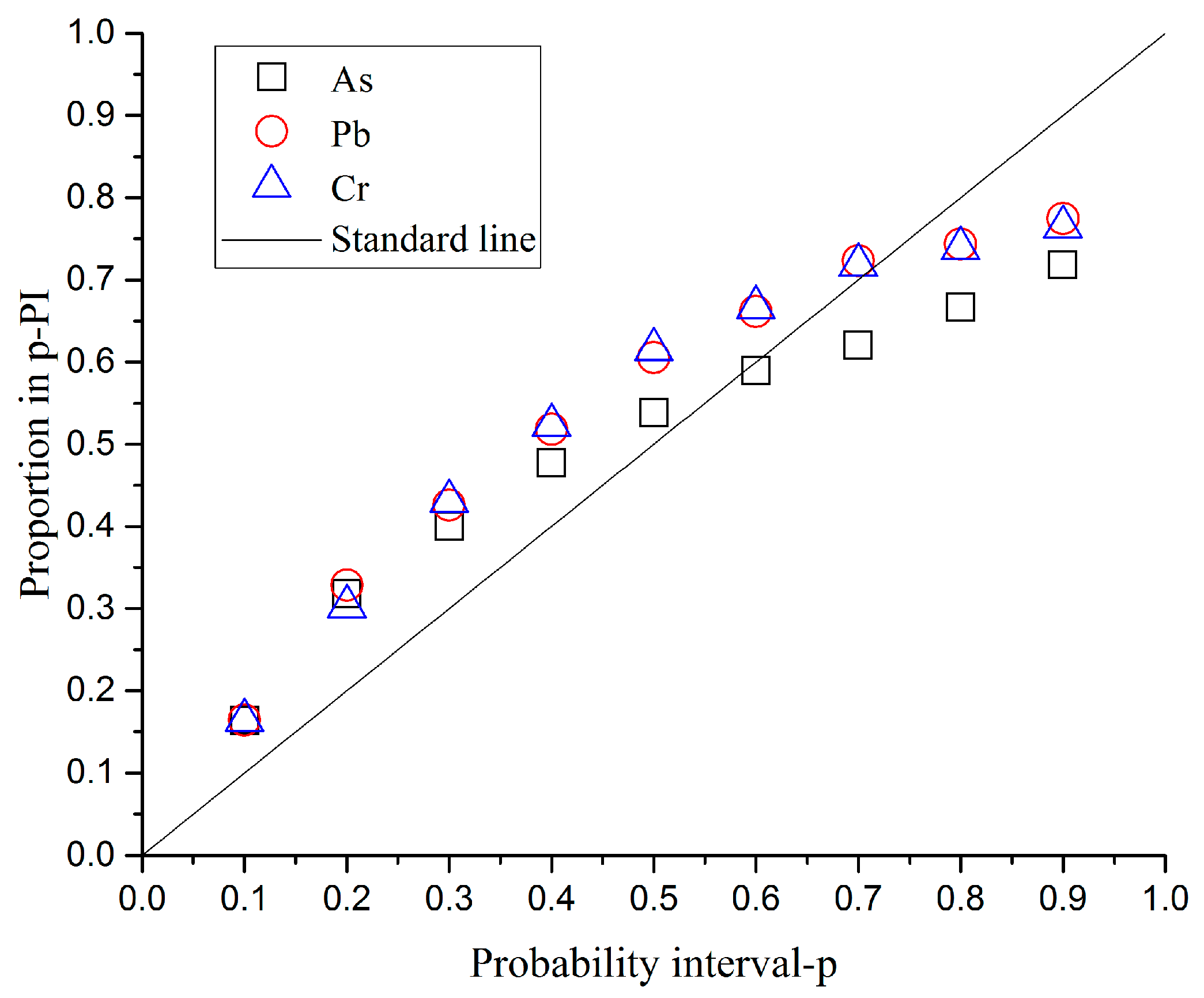
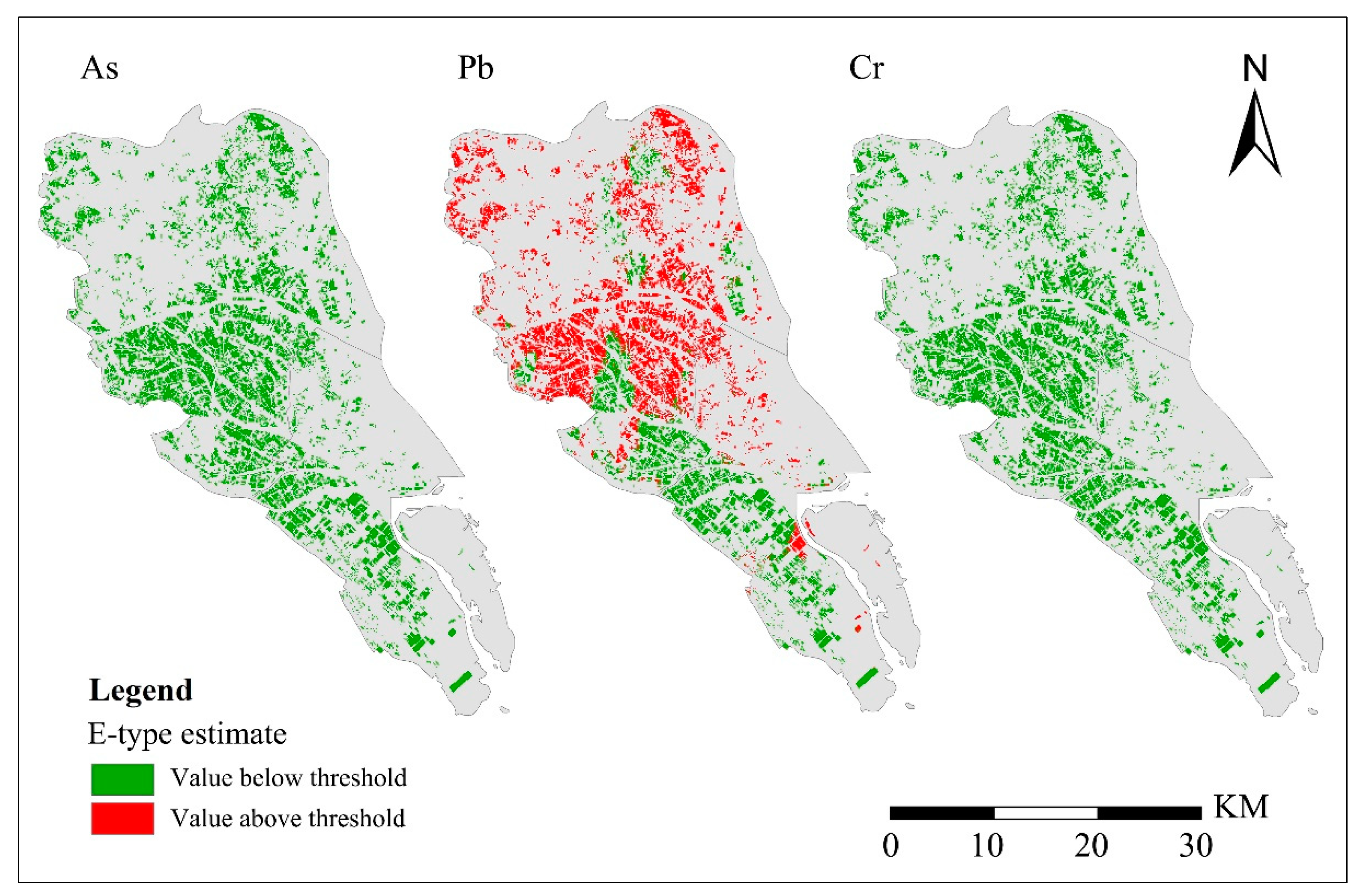
| Element | Mean (mg/kg) | Minimum (mg/kg) | Maximum (mg/kg) | Standard Deviation (mg/kg) | Skewness | Kurtosis | Coefficient of Variation | Background Value (mg/kg) | Kolmogorov-Smirnov Significance |
|---|---|---|---|---|---|---|---|---|---|
| Cd | 0.18 | 0.05 | 0.48 | 0.06 | 0.58 | 1.53 | 36% | 0.11 | 3.60 × 10−1 |
| Hg | 0.13 | 0.03 | 0.46 | 0.08 | 1.59 | 2.02 | 63% | 0.13 | 0 |
| As | 10.30 | 0.66 | 42.62 | 8.34 | 1.67 | 2.89 | 81% | 25 | 8.28 × 10−5 |
| Pb | 51.75 | 19.10 | 122.00 | 16.48 | 1.47 | 3.87 | 32% | 60 | 1.39 × 10−2 |
| Cr | 69.74 | 20.83 | 156.47 | 22.63 | 0.22 | 0.23 | 32% | 77 | 3.57 × 10−1 |
| Carcinogenic Elements | Non-Carcinogenic Elements | ||||
|---|---|---|---|---|---|
| As | Cd | Hg | Pb | Cr | |
| CR (Mean) | 2.80 × 10−5 | 6.94 × 10−7 | - | - | - |
| HI (Mean) | - | - | 0.07 | 0.98 | 0.51 |
| Threshold (mg/kg) | 36.81 | 26.27 | 1.80 | 52.85 | 137.34 |
| Elements | Sample Point | Grid Quantity (100%) | Grid Quantity (E-type) |
|---|---|---|---|
| As | 3 | 3 | 3 |
| Cr | 1 | 1 | 1 |
| Pb | 73 | 65 | 14,614 |
© 2020 by the authors. Licensee MDPI, Basel, Switzerland. This article is an open access article distributed under the terms and conditions of the Creative Commons Attribution (CC BY) license (http://creativecommons.org/licenses/by/4.0/).
Share and Cite
Yang, H.; Song, Y.; Zhu, A.-X.; Hu, Y.; Li, B. An Uncertainty Assessment of Human Health Risk for Toxic Trace Elements Using a Sequential Indicator Simulation in Farmland Soils. Sustainability 2020, 12, 3852. https://doi.org/10.3390/su12093852
Yang H, Song Y, Zhu A-X, Hu Y, Li B. An Uncertainty Assessment of Human Health Risk for Toxic Trace Elements Using a Sequential Indicator Simulation in Farmland Soils. Sustainability. 2020; 12(9):3852. https://doi.org/10.3390/su12093852
Chicago/Turabian StyleYang, Hao, Yingqiang Song, A-Xing Zhu, Yueming Hu, and Bo Li. 2020. "An Uncertainty Assessment of Human Health Risk for Toxic Trace Elements Using a Sequential Indicator Simulation in Farmland Soils" Sustainability 12, no. 9: 3852. https://doi.org/10.3390/su12093852
APA StyleYang, H., Song, Y., Zhu, A.-X., Hu, Y., & Li, B. (2020). An Uncertainty Assessment of Human Health Risk for Toxic Trace Elements Using a Sequential Indicator Simulation in Farmland Soils. Sustainability, 12(9), 3852. https://doi.org/10.3390/su12093852





